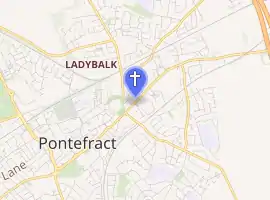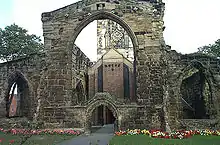All Saints' Church, Pontefract
The Church of the All Saints' in Pontefract, West Yorkshire, England is an active Church of England parish church in the archdeaconry of Leeds and the Diocese of Leeds. The church consists of two structures, an outer church constructed in the 14th and 15th century and ruined in the English Civil War and a smaller inner church completed in the late 1960s. The church has been Grade II* listed since 29 July 1950. The church is one of two Anglican churches in the town centre; the other being St Giles'
| All Saints' Church | |
|---|---|
| Church of All Saints' | |
.jpg.webp) | |

| |
| 53°41′46″N 1°18′03″W | |
| Location | North Baileygate, Pontefract, West Yorkshire |
| Country | England |
| Denomination | Church of England |
| History | |
| Status | Parish church |
| Architecture | |
| Completed | 14th-15th century (outer church) 1967 (inner church) |
| Administration | |
| Parish | Pontefract |
| Diocese | Leeds |
| Province | York |
History
The outer structure dates from the 14th and 15th century. The church was held by the Royalists at the beginning of the English Civil War; in December 1644 the Parliamentarians sieged the church which was held by the Royalists armed with 11 cannons. In the siege by Parliamentarians, the church suffered extensive damage with 60 18lb cannonballs being fired in one day from Monkhill. In June 1645, the church now under the occupation of Parliamentarians was sieged upon by Royalists who occupied Pontefract Castle. In defending the church the Parliamentarians made siege works within the already ruined church and pillaged the church of its materials. By 1649 the church roof had been completely removed.[1]
Architectural style

14th and 15th century outer church
The outer church is of 14th and 15th century origins and is largely ruinous. Alterations were made to the ruins in 1838. The outer church is of a cruciform plan; built of Ashlar sandstone with some rendering. The ruined nave with north and south porches contains the newer structure. The ruined structure has an octagonal tower added in the 18th century. There is a heavily ruined aisled chancel with a 19th-century inserted sanctuary. The south aisle of the nave has four bays with a porch in the second. The nave has a south clerestorey with four windows of twin trefoiled lights with a continuous hoodmould. The west end of the nave is buttressed flank with a four-centred arched doorway. The North nave is as the south with a two-story porch in the second bay. The central tower has paired windows each with two trefoiled lights with a quatrefoil in the arch and hoodmoulds. The tower has a clock face in an ogee crocketed canopy.[2]
20th century inner church
The inner church was completed in 1967 to a design by George G Pace.[3] It is of brick construction with a pitched roof. The front is adorned with five medieval heads.
14th and 15th century outer church
The nave has arcades with octagonal piers and pointed arches. The nave is built over with the 1967 church obscuring much of the floor plan.
20th century inner church
.jpg.webp)
The inner church was completed in 1967; it contained Victorian pews, which have since been replaced. The south chancel aisle has an ogee-headed tomb niche. The north and south walls have offset windows and the roof skylights, positioned so not to be obscured by the ruins of the outer church. The walls are whitewashed. There is a mezzanine above the entrance with a pipe organ positioned on top. There is an octagonal stone font.
Location and access
The church is located on North Baileygate; separated from the town centre by Pontefract Castle which lies to the west. The closest railway station is Pontefract Monkhill which is situated around a quarter of a mile from the church.
See also
- St George in the East - a church ruined in the Blitz with a modern church constructed within
References
| Wikimedia Commons has media related to All Saints Church, Pontefract. |
- "History of All Saints' Church". Pontefract All Saints Heritage. Retrieved 27 May 2019.
- "Church of All Saints". British Listed Buildings. Retrieved 27 May 2019.
- "All Saints' church, Pontefract - nave". Jonathan Thacker. Retrieved 27 May 2019.